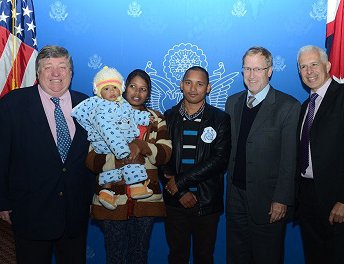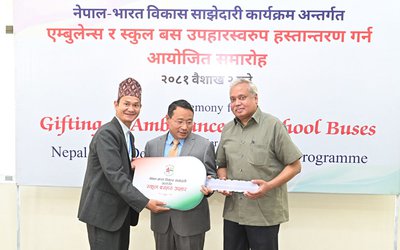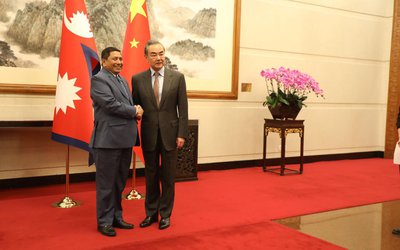
Not only in words, the United States has shown by deeds that it cares about the stateless displaced population. By offering resettlement for over 80,000 Bhutanese refugees, who lived over two decades in the refugee camps in eastern Nepal, the United States has helped the displaced population in times of their difficulties.
The 80,000th refugee from Bhutan departed from Nepal for the United States of America on December 9, 2014. The U.S. Ambassador to Nepal, Peter W. Bodde, bid a farewell to Karmi Uraw, Dil Bahadur Sarki, and their eleven-month-old son at Tribhuvan International Airport before they set out to start a new life in Columbus, Ohio.
After meeting the family, Ambassador Bodde commended the government and people of Nepal for graciously hosting the Bhutanese refugees for over 20 years, noting that, “Nepal’s history shows its commitment to protecting those who have come here seeking refuge. In that honorable tradition, I encourage Nepal to continue to act as a model for the world as a durable solution for refugees from Bhutan is found.”
The United States, in close coordination with the government of Nepal, the United Nations High Commissioner for Refugees (UNHCR), and the International Organization for Migration (IOM), began resettling refugees from Bhutan residing in eastern Nepal in 2007.
Since the first Bhutanese refugees departed Nepal seven years ago, more than 93,000 have been resettled in Australia, Canada, Denmark, the Netherlands, New Zealand, Norway, the United Kingdom, and the United States.
"Some of the 80,000 Bhutanese who have resettled in the United States have already become naturalized American citizens," a statement issued by Public Affairs Section, Embassy of The United States, said.
Sandwiched between two big powers, India and China, Nepal remains a transit for refugees and always gets respect as a good host for refugees and asylum seekers including from Tibet, Bangladesh, Burma and other parts of the world.
However, Nepal’s policy for resettlement for refugees does not match its liberal host character. Nepal has formed high level committees from time to time to issue citizenship, but it has rarely offered resettlement for refugees who want to continue to live in Nepal and rarely taken up the humanitarian concern of people who want to stay in Nepal.
Nepal is even blamed for being discriminatory for the refugees living in Nepal. Unlike Bhutanese refugees of Nepali origin who are shown all kinds of generosity, the children of Tibetan Refugees who have been living in Nepal over half decade, face discrimination. A numbers of offspring of Tibetan Refugees who are born and grow up in Nepal are deprived of official registration documents. In absence of registration document, these offspring are stateless.
Similarly, Nepal has just distributed 100 naturalized Nepalese citizenship to the foreigners and even the citizenship is denied to those whose father is foreigner and married to Nepali women. As the process of acquiring Nepali citizenship is so complicated and complex, even a person who can fulfill all criteria declined to issue citizenship or any other documents for permanent residency.
According to United Nations High Commission for Refugees, (UNHCR) 40,000 refugees and asylum-seekers in Nepal (of whom some 25,000 refugees from Bhutan live in two camps). Tibetan and Bhutanese refugees account for a large majority of Nepal’s refugee population.
“In Nepal, the Office will continue the resettlement of refugees from Bhutan and, in close cooperation with other concerned Governments, search for other durable solutions for families remaining in camps. It will continue to advocate a simpler visa-waiver process for urban refugees who are accepted for resettlement and ways to assure the safe transit of Tibetans to India. UNHCR will also seek the issuance of documentation for the long-staying Tibetan population,” said UNHCR.
Although Nepal is home to some 800,000 stateless residents, the exact number of refugees is uncertain because Nepal is not a signatory of the 1951 U.N. Convention Relating to the Status of Refugees that ensures the legal status and economic rights of refugees.
Nepal’s National Unit for the Coordination of Refugee Affairs has requested that the UNHCR not recognize additional cases of urban refugees within its borders in an effort to prevent Nepal from becoming a safe haven for illegal immigrants.
The United Nations Convention relating to the Status of Refugees, as amended by its 1967 Protocol (the Refugee Convention), defines who is a refugee and sets out the basic rights that countries should guarantee to refugees.
“UNHCR will continue to advocate a simpler visa-waiver process for urban refugees who are accepted for resettlement and ways to assure the safe transit of Tibetans to India. UNHCR will also seek the issuance of documentation for the long-staying Tibetan population,” writes UNCHR.
Although Nepal is not a signatory of the 1951 Refugees Convention, Nepal offers asylum to a considerable number of refugees. Nepal is regarded as a good host to the refugees. The time has come for Nepal to learn from the United States showing generosity to the family and children of all refugees living in Nepal.

Keshab Poudel
Poudel is the editor of New Spotlight Magazine.
- ECONOMY: Growth At 3.3
- Apr 16, 2024
- DPM’s SHRESTHA’S CHINA VISIT High Profile, Low Key
- Apr 14, 2024
- Maha Kumbha In Barahkshetra: A Sacred Festival In Sacred Koshi (Kaushiki) River
- Apr 09, 2024
- LOSS AND DAMAGE: Upper Tamakoshi A Case
- Apr 02, 2024
- Helvetas-Nepal’s InElam Promoting Herbal Oil In Sarlahi
- Mar 31, 2024
















